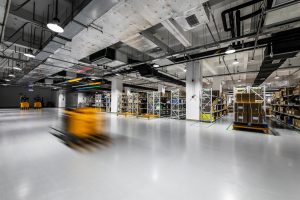What Are the Future Challenges of the Green Supply Chain?

In the same way as the spread of robotics, artificial intelligence, and the conversational economy, sustainable development is a key issue for companies in the 21st century. The consequences of mass industrialisation and consumerism in recent decades have only served to heighten concerns about the environmental impact of production and marketing processes. Optimising an environmentally friendly supply chain is a major challenge that companies will face in the coming years. How can they implement an effective green supply chain and benefit their customers? Here are some answers.
The Green Supply Chain, Both a Constraint and an Opportunity for Companies
Implementing a green supply chain addresses issues that are already essential for companies and which will prove increasingly important in the coming years. Pressure and incentives from various directions will compel them to adopt an eco-responsible approach. Examples include:
- The burden of new regulations, which will only increase, with deadlines of 2030 or 2050 in many areas;
- Supply chains have become more unpredictable due to the scarcity of certain materials (oil, cobalt, ores, etc.) ;
- Greater pressure from consumers, who now have better access to information on sustainable development and are able to identify greenwashing.
By anticipating future governmental changes, companies will be able to gain a competitive advantage while strengthening their image in the eyes of their customers, partners or institutional players by developing a CSR (Corporate Social Responsibility) approach. Moreover, in many cases, this will enable them to reduce certain areas of expenditure, despite the fact that the initial changes can be costly to implement.
The Green Supply Chain in the Production Process
Taking sustainable development into account in manufacturing begins with the choice of sources of supply. Companies of the future will make a point of using non-polluting raw materials and supplies. They will also have to base their procurement choices on the suppliers’ commitment to sustainable development (in addition to quality, price, and delivery times), as well as favouring local partners (short supply chains). Re-localisation and the prioritisation of local expertise will considerably reduce the distance and time needed to deliver supplies.
Furthermore, the production of goods inevitably leads to significant energy consumption through the use of machinery and various processes to transform raw materials. In many cases, manufacturing also requires the combustion of raw materials (oil, coal), which are the main contributors to greenhouse gas emissions.
Companies will therefore have to move towards greener production to reduce energy consumption and use clean technologies to limit their carbon footprint. Lean management techniques can, for example, contribute to a reduction in the consumption of water, electricity, and resources used in the manufacturing process. In this way, the ecological objective is combined with the economic aim of reducing costs.
Finally, optimising the production process requires a significant increase in recycling. The possibility of reusing certain materials for packaging at the end of their life cycle and re-injecting them into a new production cycle helps to reduce manufacturing costs. Limiting waste (reducing the volume of cardboard) or selective sorting are also important elements of the sustainability commitment of companies. This eco-design approach, which takes into account the entire life cycle of a product, from its development to its recycling, is another aspect where companies still have a lot of room for improvement in terms of taking into account their ecological commitment.
Green Supply Chain And Storage: The Eco-Responsible Warehouse
Beyond the manufacture of products, the challenge of the green supply chain also lies to a large extent in the ability of companies to set up environmentally friendly logistics systems that promote sustainable development. This means integrating environmental criteria into the company’s ERP (data centralisation software) in the same way as other costs, quality, or lead time criteria are.
When planning logistics, the first elements to consider are the location of the warehouse, its layout, and the materials used in its design. The use of renewable energy sources, such as solar photovoltaics, wind turbines, hydroelectric plants, and rainwater harvesting and treatment systems are solid foundations on which companies can build the sustainable warehouse of the future.
Beyond the warehouse itself, the entire inventory order chain must support the implementation of green logistics. A WMS (Warehouse Management System) should make it possible to optimise the processing and preparation of orders so as to reduce implementation costs, as well as to limit the number of energy-consuming journeys for each operation.
To this end, the use of advanced technologies will eventually enable substantially automated and autonomous logistics management via EDI (electronic data interchange) systems, RFID chips, and numerous management tools displaying the location of stored supplies or products. Robotic automation will continue to be expanded and will further contribute to order preparation (packaging), packing (palletisation), and the loading and tracking of lorries and containers.
We are therefore moving towards greater control of the impact of logistics, not only on the external environment (responsible construction of buildings, reduction of pollution, waste treatment, eco-management of energy) but also on the internal environment (worker comfort, health quality of the premises).
Green Supply Chain: The Transport Revolution
The green supply chain of the future will also involve major changes to the final link in the production chain, i.e. transport, be it in terms of the delivery, supply, or routing of goods. Round trips should therefore be optimised to avoid unladen journeys.
With regard to deliveries, the problem of the last mile, which is not only costly but also generates significant carbon emissions, especially when the parcel cannot be delivered to the recipient and requires redelivery, must be addressed.
To this end, delivery to drop-off points, which is becoming more and more common, must be expanded further. Another solution may be drone delivery, which ought to provide an answer to all these problems, even if the legal framework and practical applications have yet to be defined. This could prove particularly useful for managing the return of goods.
Furthermore, river or rail transport should be prioritised in place of road or air. When these alternatives are not possible, the use of biofuels (ethanol, ETBE, vegetable, or oilseed oils), as well as route optimisation, will reduce polluting emissions and the environmental impact of production and transport. The transport of the future will also involve the widespread use of electric and hydrogen-powered vehicles, particularly in the areas of freight and logistics.
These developments in the transport sector should also be reflected in the renewal of the commercial fleet, where hybrid or electric cars should eventually become the norm. The total elimination of diesel vehicles is an important first step in implementing this sustainable approach.
In conclusion, companies must adopt a global approach, in which sustainable development is integrated across all stages of the production process. Beyond the environmental commitment, which is now a major factor in consumer choice, the green supply chain is also an opportunity for companies to completely review their production and marketing methods while at the same time streamlining their costs.
For more information please visit: www.manutan.co.uk/future-of-work




